Updated 28 June 2025 at 22:35 IST
Prada Admits Lifting Kolhapuri Chappal Design from India After Backlash Over ₹1.2 Lakh Price
Prada Acknowledges Copying India’s Kolhapuri Chappals, After Showcasing Rs 1.2 Lakh Footwear In 2026 Collection.
- Viral News
- 3 min read

A renowned Italian luxury brand, Prada, recently unveiled its Men's Spring/Summer 2026 collection, where it showcased what it called "leather flat sandals", priced at ₹1.2 lakh.
However, the design drew immediate attention for its striking resemblance to Kolhapuri chappals, the traditional handcrafted leather footwear rooted in Indian heritage.
The open-toed leather sandals presented during the Milan show sparked criticism across India for resembling the iconic Kolhapuri chappals, crafted for centuries by artisans in Maharashtra and Karnataka, without acknowledging the design’s cultural roots.
The backlash intensified online, with many accusing Prada of cultural appropriation. The criticism further escalated after it emerged that the brand had not credited Indian artisans or acknowledged the traditional inspiration behind the product.
Advertisement
Prada Responds to Criticism
In response to the mounting outrage, Prada reportedly issued a statement admitting that the sandals were indeed inspired by Indian craftsmanship.
The company stated, "Prada acknowledges that sandals inspired by traditional Indian footwear made in specific districts in Maharashtra and Karnataka, India, were featured in its Men's 2026 Spring Summer show in Milan. We are committed to responsible design practices, fostering cultural engagement, and opening a dialogue for a meaningful exchange with local Indian artisan communities, as we have done in the past in other collections, to ensure the rightful recognition of their craft. We are in contact with the Maharashtra Chamber of Commerce, Industry & Agriculture on this topic."
Advertisement
The move to acknowledge the design came only after significant backlash and pressure from both social media users and officials calling for the rightful recognition of Indian artisans.
What’s So Unique About Kolhapuri Chappals?
Kolhapuri chappals are handcrafted leather slippers with origins dating back to the 12th century. They are made using traditional techniques passed down through generations, mainly in Maharashtra.
In 2019, Kolhapuri chappals were granted a Geographical Indication (GI) tag, officially recognizing their unique link to a specific region and offering protection to local artisans by safeguarding their traditional knowledge and cultural heritage.
This GI status not only reinforces the design’s heritage value but also aims to prevent misappropriation or misuse. Many in India are now questioning whether Prada’s actions violated these protections by marketing a similar product without initially crediting the source of its inspiration.
Can Legal Action Be Taken Against Prada?
Despite public outrage, legal experts believe that pursuing legal action against Prada may be difficult under current international laws.
Senior Lawyer Ameet Naik noted that a GI infringement claim may not be strong enough to succeed.
“Prada has taken a view that these are flat sandals and that there is no misrepresentation. A passing off action could be explored, but may not be a strong case of infringement. Prada could have avoided controversy by clearly acknowledging the Indian inspiration behind the design,” he said.
According to a report by The Economic Times, the Sant Rohidas Leather Industries & Charmakar Development Corporation (LIDCOM), which co-owns the GI certification along with Karnataka’s LIDKAR, is considering legal measures. However, GI protection is currently limited to within India’s borders, and there are no enforceable international legal safeguards for GI marks.
Legal experts clarified that while GI laws protect names and geographic identities from commercial misuse, they do not extend protection against imitation of design or appearance, which makes the case more challenging.
Published By : Bhawana Gariya
Published On: 28 June 2025 at 22:35 IST
